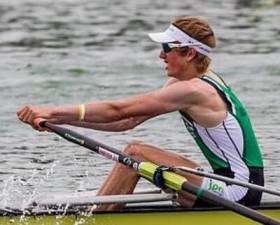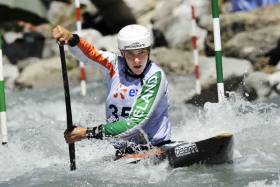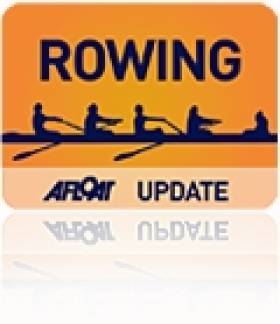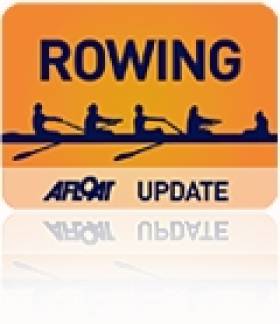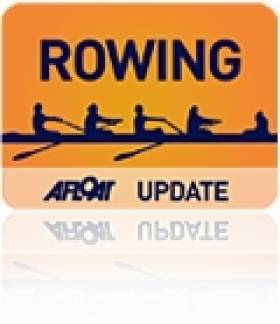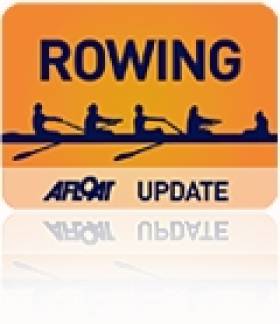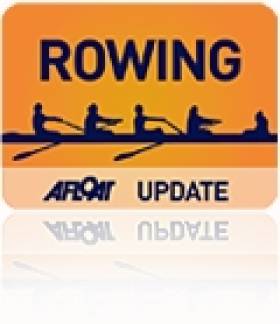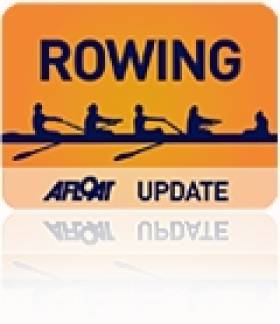Displaying items by tag: Under23
O'Malley and Mulvaney Hit the Mark at World Rowing Championships
# Rowing: Ireland’s campaign at the World Championships in Rotterdam, which feature senior, under-23 and junior events, started well this morning. The Ireland Under-23 lightweight pair of David O’Malley and Shane Mulvaney secured a semi-final place. Greece and Turkey swapped places ahead of them, but the Ireland crew nailed down third and direct qualification. Germany struggled and could only take fourth and a repechage place. Turkey passed Greece before the line.
World Rowing Championships, Rotterdam (Selected Results; Irish interest)
Men
Under-23 Lightweight Pair - Heat Two (First Three to A/B Semi-Final; rest to Repechages): 1 Turkey 6:39.80, 2 Greece 6:40.70, 3 Ireland (S Mulvaney, D O’Malley) 6:45.09.
#Canoeing: Liam Jegou topped the rankings in his first run and qualified directly for the semi-finals at the canoe slalom under-23 World Championships in Krakow in Poland. The Ireland C1 competitor had a fault-free round in 83.55 seconds. Ireland’s two other contenders in this class fell outside the qualificaton mark: Robert Hendrick missed gate 10 and incurred a 50-second penalty in an otherwise steady run. Jake Cochrane touched gates 12 and 14 and then missed gates 17 and 18, to finish 60th. Hendrick finished 15th in his second run and Cochrane 27th.
Canoe Slalom World Championships, Under-23 and Junior, Krakow, Poland (Irish interest; selected results):
Men
Under-23 C1 – First Run (20 qualify directly for semi-finals): 1 Ireland (L Jegou) 83.55 seconds; 54 R Hendrick 141.89; 60 J Cochrane 200.64. Second Run (10 qualify): 15 Hendrick 94.87; 27 Cochrane 100.74.
Junior C1 – First Run (20 qualify): 41 Ireland (E Moorhouse) 120.92; 49 F McNally 164.94. Second Run: 20 McNally 113.71; 34 Moorhouse 162.06.
Walsh Fourth in Heat at World Under-23 Rowing
#ROWING: Denise Walsh of Ireland finished fourth in her heat of the lightweight single sculls at the World Under-23 Championships in Varese, Italy, this morning. The two direct qualification places were taken by Anna Ioannou of Cyprus and Julie Marechal of France, whose battle at the head of the race drew them away from the rest of the contenders. Britain’s Emily Craig was third, while Walsh and Anastasia Lebedeva of Russia fought it out at the back of the field to avoid last. The Skibbereen woman prevailed.
World Under-23 Rowing Championships, Varese, Italy, Day Two (Irish interest; selected results)
Women
Lightweight Single Sculls – Heat Three (First Two Directly to A/B Semi-Finals; Rest to Repechage): 1 Cyprus 8:04.62, 2 France 8:06.67; 3 Britain 8:13.89, 4 Ireland (D Walsh) 8:22.48, 5 Russia 8:26.00.
#ROWING: Paul O’Donovan won his heat of the lightweight single sculls at the World Under-23 Rowing Championships at Varese in Italy today. Britain’s Sam Mottram held the lead in the middle stages of the race, but O’Donovan passed him and won, with Brazil and Japan taking the other qualifying places for the quarter-finals.
The Ireland four of Richie Bennett, Kevin Neville, Fionán McQuillan-Tolan and Rob O’Callaghan finished fifth in their heat and will compete in a repechage tomorrow. The Irish could not find a way into contention for the top-three spot they needed. Italy won from Croatia and the United States. Belarus took fourth.
World Under-23 Championships, Varese, Italy. Day One (Selected Results; Irish interest)
Men
Four – Heat One (First Three to A/B Semi-Finals): 1 Italy 6:00.06, 2 Croatia 6:02.31, 3 United States 6:05.38; 4 Belarus 6:07.95, 5 Ireland (R Bennett, K Neville, F McQuillan-Tolan, R O’Callaghan) 6:22.36.
Lightweight Single Sculls (First Four to Quarter-Finals): 1 Ireland (P O’Donovan) 7:08.58, 2 Britain 7:11.14, 3 Brazil 7:19.02, Japan 7:20.05; 5 Portugal 7:22.59.
Ireland Team For World Under-23 Rowing Named
#ROWING: Rowing Ireland has announced the crews which will compete at the Under-23 World Rowing Championships in Varese, Italy, from 23rd to 27th July.
Denise Walsh will compete in the lightweight single scull. Walsh, who is 22 years old, competed in the same event last year, finishing sixth. She has been competing more recently in a newly formed lightweight double scull with Claire Lambe. They finished in 5th position in the B final in their first outing two weeks ago at World Cup II in Aiguebelette. Denise Walsh rows for Skibbereen Rowing club and is in her final year of studying Economics and Geography at UCC.
Paul O’Donovan finished in third place in U23 lightweight men’s scull in Linz, Austria in 2013. He comes from a strong family of rowers, with his father, Teddy, involved in Skibbereen rowing Club. Paul rowed himself since the age of seven. In the recent World Cup II regatta in Aiguebelette Paul won the B final.
Paul’s brother Gary will compete in the men’s lightweight double, together with fellow Skibbereen man Shane O’Driscoll. Gary is passionate about the sport. “My father always had an interest in rowing and he would bring myself and Paul to a lot of rowing events before we started rowing, which we enjoyed a lot,” Gary recalled. “When I was 10 years old, he brought me and Paul rowing for the first time. Since then we have never stopped.”
Shane O’Driscoll, who was in Gary’s class in school, started rowing shortly afterwards and they have rowed together since.
The men’s four from Galway will be hoping for a good result. Many of the crew have rowed since they were at junior level. Richie Bennett and Rob O’Callaghan competed in the four at last year’s Under-23 World Championships, where they finished ninth. Fionnán McQuillan-Tolan recently lined out in the Boston College eight at the Eastern Sprint regatta. Tolan started rowing at St Joseph’s College and won three junior Championships with them.
Ireland Under-23 World Championship Team:
Men
Four: Fionnán McQuillan-Tolan (Grainne Mhaol RC), Richard Bennett (NUIG BC), Robert O'Callaghan (NUIG BC), Kevin Neville (NUIG BC). Lightweight Double Scull: Gary O’Donovan (CIT RC), Shane O’Driscoll (Skibbereen RC). Lightweight Single Scull: Paul O’Donovan (UCD).
Women
Lightweight Single Scull: Denise Walsh (Skibbereen RC).
Ireland Pipped on Line by Britain in B Final
Ireland were pipped on the line by Britain in the B Final of the lightweight quadruple sculls at the World Under-23 Rowing Championships in Amsterdam. Ireland took the lead within metres of the finish only for Britain to come through and win by seven hundredths of a second. Ireland’s crew of Shane O’Driscoll, Niall Kenny, Peter Hanily and Justin Ryan thus finish eighth overall.
Jonathan Mitchell won a battle for fourth with Switzerland’s Jerome Voelke in the C Final of the lightweight single scull, placing him 16th overall. At the head of the field, Cristian Gainza Lein of Chile held off the late challenge of Kamal Mammadov of Azerbaijan, with Oskar Russberg of Sweden third.
World Under-23 Rowing Championships, Amsterdam - Day Four (Irish interest)
Men
Lightweight Quadruple Scull – B Final (Places 7 to 12): 1 Britain 5:55.87, 2 Ireland (S O’Driscoll, N Kenny, P Hanily, J Ryan) 5:55.94, 3 Spain 5:59.67, 4 Netherlands 6:01.04, 5 Austria 6:02.97, 6 Turkey 6:20.13.
Lightweight Single Scull – C Final (Places 13-18): 1 Chile 7:14.52, 2 Azerbaijan 7:15.39, 3 Sweden 7:15.65, 4 Ireland (J Mitchell) 7:22.21, 5 Switzerland 7:25.61, 6 Italy 7:53.08
Women
Lightweight Double Scull – Semi-Final One (First Three to A Final; rest to B Final): 1 Greece 7:03.80, 2 Spain 7:05.59, 3 Netherlands 7:06.49; 4 Romania 7:12.98, 5 Austria 7:14.20, 6 Ireland (S Dolan, C Lambe) 7:14.86.
Single Scull – Semi-Final One (First Three to A Final; rest to B Final); 1 Serbia (I Filipovic) 7:36.42, 2 Estonia (K Pajusalu) 7:36.89, 3 Azerbaijan (I Angelova) 7:36.94; 4 Ukraine 7:38.55, 5 Ireland (L Dilleen) 7:43.02, 6 Denmark 8:14.00.
Queen's Man in World Rowing Quarter-Finals
Jonathan Mitchell qualified for the quarter-finals of the lightweight single scull at the World Under-23 Championships in Amsterdam. The Queen’s University man finished third in his heat, behind Germany and Sweden.
World Under-23 Rowing Championships, Amsterdam, Day Two (Irish interest):
Men
Lightweight Single Scull – Heat Six (First Three to Quarter-Finals): 1 Germany (R Acht) 7:47.10, 2 Sweden (O Russberg) 7:53.46, 3 Ireland (J Mitchell) 7:59.95; 4 Chile 8:03.41
The World Under-23 Rowing Championships, which begins on Wednesday in Amsterdam, have drawn a record number of 63 competing nations. Last year Ireland took a silver medal in the lightweight quadruple scull and we will be again represented in this class with Shane O’Driscoll and Peter Hanily coming into the crew for Mark O’Donovan and Michael Maher, who have moved out of this age group. Lisa Dilleen (20), who finished ninth in the single scull last year, gets another chance in this class. The lightweight double of Sarah Dolan and Claire Lambe and lightweight single sculler Jonathan Mitchell will also represent Ireland.
Ireland Team for World Under-23 Rowing Championships, Amsterdam, July 20th-24th
Men – Lightweight Quadruple: S O’Driscoll, N Kenny, P Hanily, J Ryan. Lightweight Single Scull: J Mitchell.
Women – Lightweight Double Scull: S Dolan, C Lambe. Single Scull: L Dilleen.


























